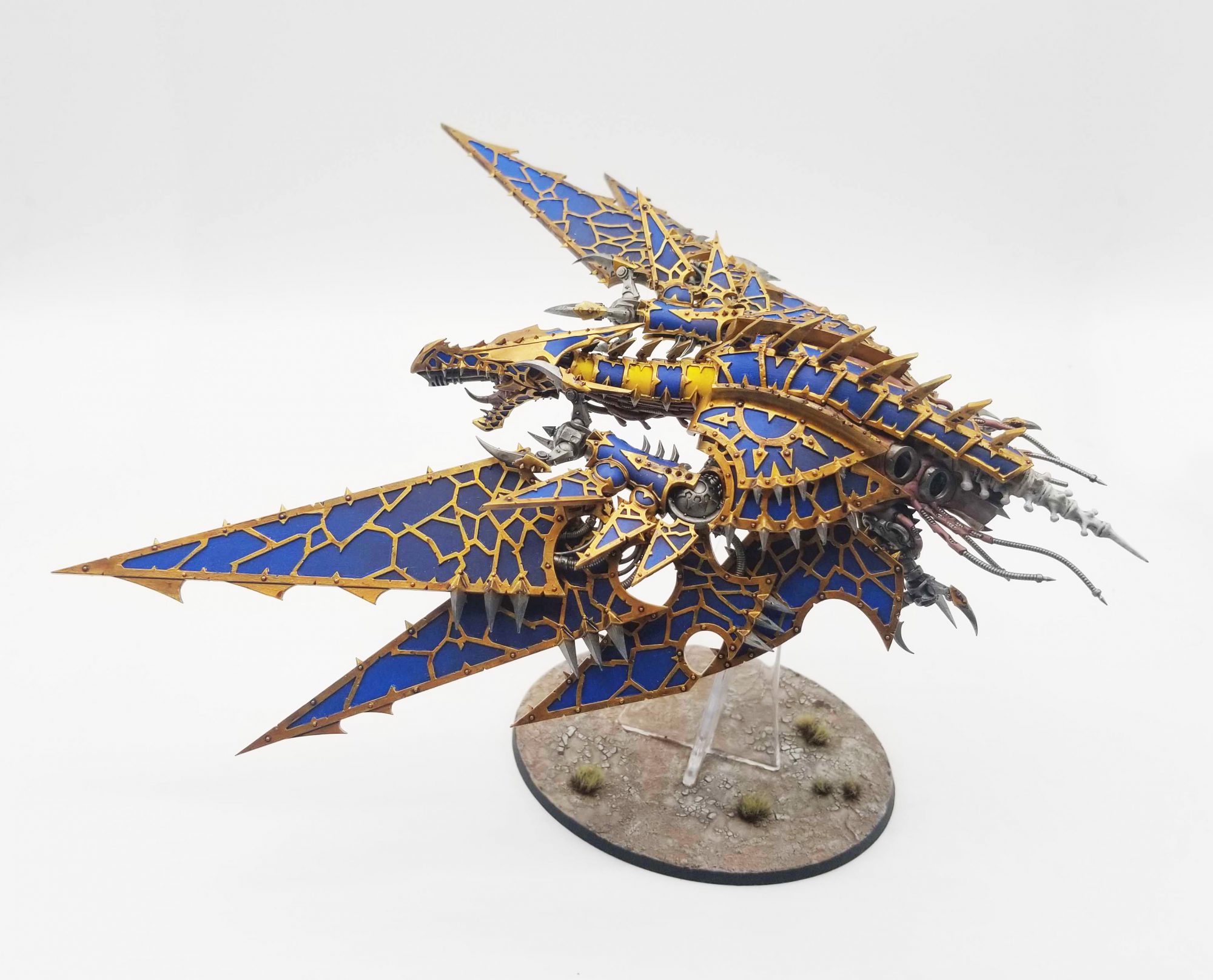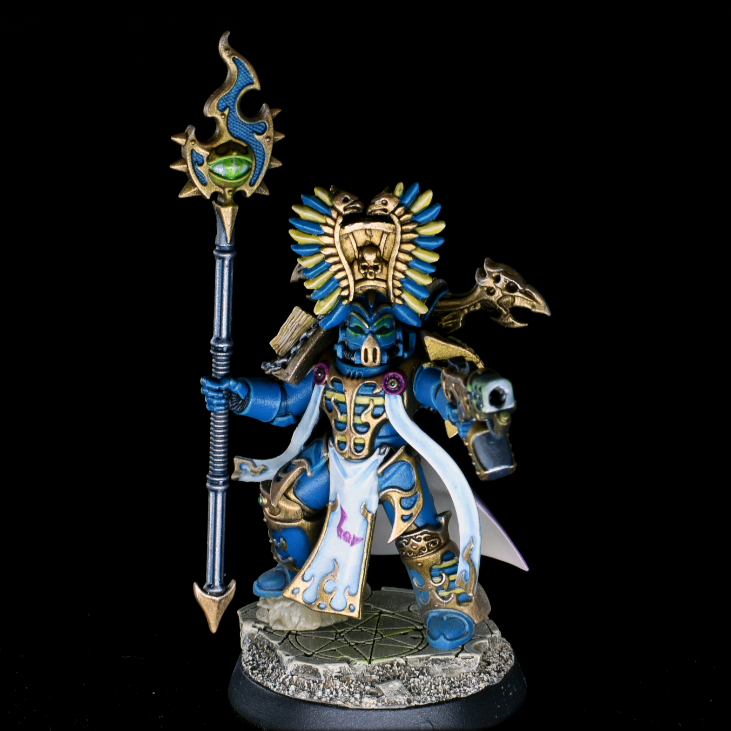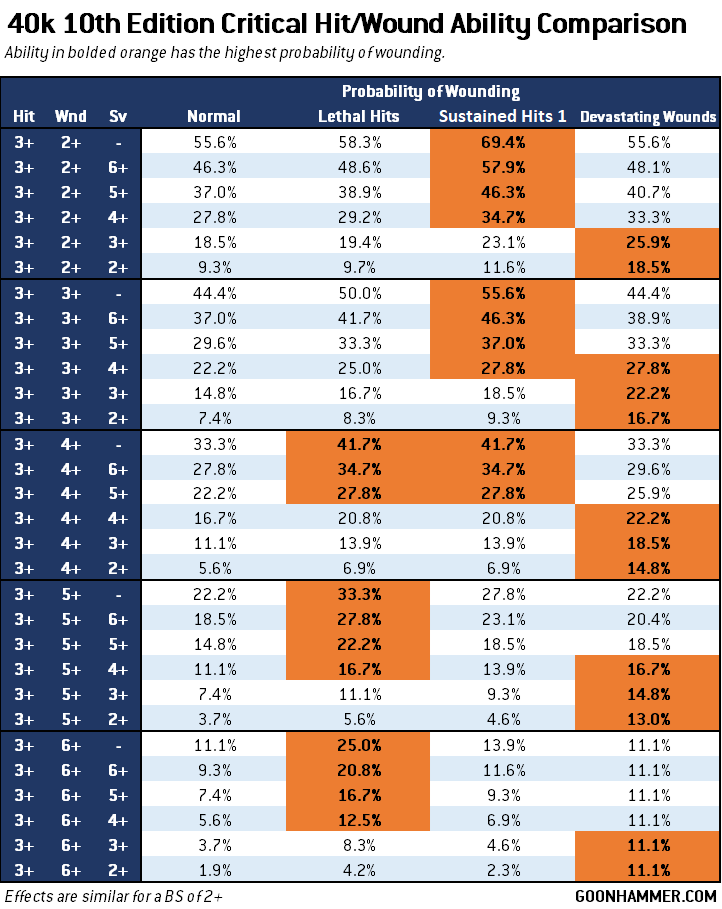This week’s Hammer of Math looks at the effects and synergies of the Kindred Sorcery detachment rule for Thousand Sons Cults of Magic in Warhammer 40k.
I don’t envy the folks who write rules at Games Workshop. There’s a lot of things to get right, it’s trivial to enrage an entire faction’s worth of players with a single rule, and people are constantly doing everything in their power to exploit and abuse unintended synergies and interactions to achieve an advantage. On top of it you have people spending hours upon hours writing articles about the probabilities and calculations that define what ideally should be a casual game you play over beers with your mates at the local game club. If that wasn’t enough, you also want to maintain a thematic element to keep the factions unique. World Eaters are supposed to be angry and choppy, Aeldari are supposed to be bullshit, and Thousand Sons are supposed to be space wizards.

As befitting an entire faction of genetically enhanced warrior psykers leading a host of magical armored golems, the Thousand Sons primary abilities revolve heavily around the concept of Psychic attacks and magic. The Army Rule, Cabal of Sorcerers, allows the faction to leverage the strength of their psykers to create Rituals which can dramatically affect a targeted part of the battle. The available detachment, Cult of Magic, provides the Kindred Sorcery ability which applies a bonus to all psychic weapons in the army. Unsurprisingly, there are a lot of psychic weapons.
Cabal of Sorcerers
Every Command Phase the Thousand Sons player generates a number of Cabal points equal to the sum of all abilities on the table. Different models generate a different number of points, ranging from 4 from Magnus to 2-3 for leader Characters and 1 for Aspiring Sorcerers. Thousand Sons can then use these points to initial Rituals at the start of different phases. Each of these abilities targets a specific unit. A Ritual can only be used once per phase and is focused on a specific PSYKER model who then channels the effect to the target. For the purposes of squads like Rubrics, only the Aspiring Sorcerer is treated as a PSYKER.
Rob: Generally speaking, you’ll be generating between 12 and 21 points per turn, depending on what you’re running and how hard you go on Thousand Sons units.
Weaver of Fates (2): This cheap option allows you to re-roll one failed saving throw within 18″ of the PSYKER. Re-rolls are a beloved part of Warhammer 40k and the effect is heavily dependent on the target save. Note that you have to use this ritual at the start of the phase you’ll be using the re-roll in, so you have to declare who’s using in advance. You can use it anyone within 18″ however, so you have some flexibility.
Temporal Surge (5): With mobility playing a major role in Tactical Missions, this ability can come in handy. It allows a friendly unit within 18″ of the PSYKER to make an additional Normal Move at the start of the Shooting phase – but it cannot charge afterward. It can still shoot just fine, however.
Echoes from the Warp (6): The Psyker’s unit can freely use a Stratagem (even one that’s already been used that phase) for 0CP. Goes very well with Warp Sight for 2CP, or to use Fire Overwatch a second time in the same phase.
Doombolt (7): It wouldn’t be Thousand Sons without this direct fire psychic attack which targets a visible enemy unit within 18″ at the start of the Shooting phase and inflicts between D3 and D3+6 wounds depending on the result of a D6 roll (D3 on a 1, D3+3 on a 2-5, D3+6 on a 6). On average this attack will inflict 5 mortal wounds.
Twist of Fate (9): The most expensive Ritual has by far the most impactful ability. Pick an enemy unit within 18″ of (and visible to) the casting PSYKER at the start of any phase – that unit cannot make any armour saving throws during that phase. The impact of this ability obviously depends on the circumstances of the target, but reducing a 2+ to nothing can be crippling. Even taking a unit of Custodes from a 3+ save to a 4+ can be huge.

Kindred Sorcery
The detachment-specific ability for the Cult of Magic takes effect at the start of each of your Command phases and allows you to pick between [LETHAL HITS], [SUSTAINED HITS 1], and [DEVASTATING WOUNDS] for every psychic weapon in your army. I wrote about equilibrium points between these abilities previously, but since Thousand Sons can apply all three and generate some additional effects, it’s worth expanding the comparison.
 The effect shows two strong trends. First, with the exception of the 2+ and 6+ wound edge cases, [DEVASTATING WOUNDS] has the highest probability of wounding against anything with a modified save of 4+ or better. On the edge cases the cutoff point is an effective save of 3+ or better. Between [LETHAL HITS] and [SUSTAINED HITS 1] the equilibrium point is a wound roll of 4+. Against targets that are easier to wound than a 4+ [SUSTAINED HITS 1] is the ideal option, while targets that are harder to wound than a 4+ need [LETHAL HITS]. The effect is similar for a BS of 2+.
The effect shows two strong trends. First, with the exception of the 2+ and 6+ wound edge cases, [DEVASTATING WOUNDS] has the highest probability of wounding against anything with a modified save of 4+ or better. On the edge cases the cutoff point is an effective save of 3+ or better. Between [LETHAL HITS] and [SUSTAINED HITS 1] the equilibrium point is a wound roll of 4+. Against targets that are easier to wound than a 4+ [SUSTAINED HITS 1] is the ideal option, while targets that are harder to wound than a 4+ need [LETHAL HITS]. The effect is similar for a BS of 2+.
Certain units gain the ability to re-roll hits, wounds, or both with either re-rolling 1s or re-rolling everything. In terms of equilibrium points re-rolling 1s to hit does not affect the equilibrium points between the abilities. The same is true for re-rolling hits. Re-rolling 1s to wound makes [LETHAL HITS] less effective, and is only the preferred option compared to [SUSTAINED HITS 1] for wound rolls of 5+ or 6+. Re-rolling wounds maintains the same balance between [LETHAL HITS] and [SUSTAINED HITS 1] as re-rolling 1s to wound, but [DEVASTATING WOUNDS] becomes better. When re-rolling wounds, [DEVASTATING WOUNDS] is the preferred choice for saves of 3+ or better for wound rolls of 4+ or 5+, and saves of 4+ or better for wound rolls of 6+.
Rob: The big thing to be aware of here is how you can shift these probabilities up or down using things like Magnus’ aura (which gives +1 to hit and wound for PSYCHIC attacks), the Ensorcelled Infusion Stratagem (bolters become S5 PSYCHIC weapons), and the Twist of Fate Cabbalistic Ritual. That last one is particularly interesting, since when your opponent can’t take a save, Devastating Wounds becomes meaningless – Sustained Hits is the play at that point because every wound may as well be a mortal wound – the only difference is if you need spillover.
In a broad case approach, you’ll generally want SUSTAINED HITS over DEVASTATING WOUNDS, in part because many of your psychic powers already come with Devastating Wounds. The cases where you need it most are going to be on Magnus’ blast attack and the Infernal Master running Arcane Vortex. It’s also worth noting that LETHAL HITS tends to only be marginally better in situations where you’re on a 5+ to wound, and there the increased upside of Sustained Hits might still make for a preferable play. You definitely want LETHAL HITS if you’re going to be wounding on a 6+, however.
Wrapping Up
Thousand Sons have access to some interesting and pretty compelling abilities, and when their faction rule is combined with their detachment the synergy is excellent. It may make sense to have you weapons gain [DEVASTATING WOUNDS] against an armored target, but if you have a Ritual that allows you to strip away their armour save then suddenly getting more shots in is far more advantageous. The level of nuance here is pretty cool, but hopefully the charts and references will be useful as you traverse down the winding paths that the Lord of Change has put in front of you.
Thanks for reading! If you have any questions or comments feel free to drop us a note in the Comments below or email us at contact@goonhammer.com. That’s the best way to suggest topics for future articles.



You must be logged in to post a comment.